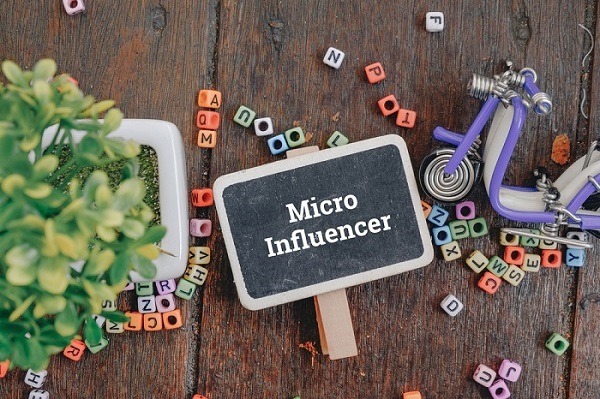
 Data Structure
Data Structure Networking
Networking RDBMS
RDBMS Operating System
Operating System Java
Java MS Excel
MS Excel iOS
iOS HTML
HTML CSS
CSS Android
Android Python
Python C Programming
C Programming C++
C++ C#
C# MongoDB
MongoDB MySQL
MySQL Javascript
Javascript PHP
PHP
- Selected Reading
- UPSC IAS Exams Notes
- Developer's Best Practices
- Questions and Answers
- Effective Resume Writing
- HR Interview Questions
- Computer Glossary
- Who is Who
The Power of Micro-Influencers: Why Smaller Followings Can Mean Bigger Results
In the world of influencer marketing, it's easy to assume that the bigger the following, the better the results. However, recent studies have shown that micro-influencers - those with smaller but highly engaged followings - can be just as effective, if not more so, than their macro-influencer counterparts. In this article, we'll explore the power of micro-influencers and why smaller followings can mean bigger results for brands.
What are Micro-Influencers?

Micro-influencers are those who have a modest but very active social media following. Typically, they have between 1,000 and 100,000 followers, with the sweet spot being around 10,000. They often have a specific niche or area of expertise that they focus on, such as fitness, beauty, or travel. Their followers trust them and view them as experts in their field, making them ideal partner for brands looking to tap into a specific audience.
Why are Micro-Influencers Effective?
There are several reasons why micro-influencers can be more effective than macro-influencers ?
Authenticity ? Micro-influencers are seen as more authentic and trustworthy than macro-influencers. They have a closer relationship with their followers and are more likely to have genuine interactions with them. This means that when they recommend a product or service, their followers are more likely to trust their opinion.
Engagement ? Micro-influencers typically have higher engagement rates than macro-influencers. This is due to the fact that their fans are more engaged with and involved in their material. This means that when a brand partners with a micro-influencer, they have a higher chance of reaching a highly engaged audience.
Cost-effective ? Working with micro-influencers can be more cost-effective than working with macro-influencers. Micro-influencers often charge lower rates than their macro counterparts, and brands can work with multiple micro-influencers for the same price as one macro-influencer.
Niche Audiences ? Micro-influencers often have a highly targeted and niche audience. This means that when a brand partners with a micro-influencer, they can reach a specific audience that is interested in their product or service. Higher conversion rates and a greater return on investment may result from this.
Examples of Micro-Influencer Success Stories
There are many examples of brands that have successfully partnered with micro-influencers. Here are a few examples ?
Glossier ? Beauty brand Glossier has built its entire marketing strategy around micro-influencers. The brand has a dedicated program that allows micro-influencers to earn commission on sales they generate. This has led to a highly engaged community of micro-influencers promoting Glossier products, which has helped the brand grow rapidly.
Daniel Wellington ? Watch brand Daniel Wellington has also had great success with micro-influencer partnerships. The brand has worked with many micro-influencers on Instagram, who have promoted the brand's watches to their highly engaged followers. This has helped the brand reach a new audience and drive sales.
HelloFresh ? Meal kit delivery service HelloFresh has partnered with many micro-influencers to promote their products. These micro-influencers have created content showcasing the meals they have made using HelloFresh ingredients, which has helped the brand reach a highly engaged audience and increase sales.
The Best Micro-Influencers for Your Brand: How to Find Them?
Finding the right micro-influencers for your brand can be a daunting task. You may use the following advice to locate the ideal micro-influencers for your brand ?
Define your target audience ? Before you begin looking for micro-influencers, you must first define your target audience. Who are you trying to reach with your product or service? What are their interests and demographics? This will help you narrow down your search for micro-influencers who have a following that aligns with your target audience.
Use influencer platforms ? There are many influencer platforms available that can help you find micro-influencers in your niche. Some popular platforms include Upfluence, AspireIQ, and Tribe. These platforms allow you to search for influencers based on their niche, follower count, engagement rate, and other criteria.
Search social media ? You can also find micro-influencers by searching social media platforms like Instagram and TikTok. Use hashtags relevant to your niche to find influencers who are already creating content in your industry. Look for influencers with a highly engaged following and a style that aligns with your brand.
Check engagement rates ? When evaluating potential micro-influencers, it's important to check their engagement rates. Look for influencers with a high engagement rate, which is the percentage of followers who engage with their content through likes, comments, and shares. A high engagement rate is a good indicator of an influencer's ability to connect with their audience and drive action.
In recent years, micro-influencers have become an increasingly popular option for brands looking to harness the power of influencer marketing. In addition to the examples mentioned earlier, there are many more success stories that highlight the effectiveness of micro-influencers.
One such example is the outdoor apparel and gear company, The North Face. The company partnered with a group of micro-influencers in 2018 to launch a new line of insulated jackets. The micro-influencers were chosen based on their engagement rates, niche expertise, and alignment with the brand's values. The campaign was a huge success, generating over 11 million impressions and a 5.4% engagement rate. The campaign also helped increase sales of the new jacket line by 60%.
Another example is the skincare brand, Dermalogica. The company partnered with a group of micro-influencers to promote its new line of products for sensitive skin. The micro-influencers were chosen based on their expertise in skincare and their highly engaged following. The campaign generated over 2 million impressions and a 6.4% engagement rate. The campaign also helped increase sales of the new sensitive skin line by 40%.
These examples highlight the power of micro-influencers to connect with their audience and drive action. By partnering with micro-influencers who have a genuine interest in their products or services, brands can tap into a highly engaged and targeted audience. This leads to increased brand awareness, higher conversion rates, and a better return on investment.
One of the reasons why micro-influencers are so effective is because of their ability to create authentic and relatable content. Unlike macro-influencers who often have a team of photographers, videographers, and editors, micro-influencers tend to create content on their own. This means that their content is often more personal and authentic, which resonates with their followers.
Another reason why micro-influencers are effective is because they have a highly engaged following. Micro-influencers tend to have a more intimate relationship with their followers, which leads to more genuine interactions and a higher engagement rate. This means that when they promote a product or service, their followers are more likely to take action.
Finally, micro-influencers are often more cost-effective than macro-influencers. This is because they tend to charge lower rates and are often willing to work with brands in exchange for products or services. Brands can also work with multiple micro-influencers for the same price as one macro-influencer, which allows them to reach a wider audience.
Conclusion
Micro-influencers can be a powerful tool for brands looking to reach a specific audience. With their highly engaged followings and niche expertise, micro-influencers can be just as effective, if not more so, than their macro-influencer counterparts. By partnering with the right micro-influencers, brands can tap into a highly engaged and targeted audience, leading to increased brand awareness and sales. When looking for micro-influencers, it's important to define your audience, use influencer platforms, search social media, and check engagement rates to find the right partners for your brand.

